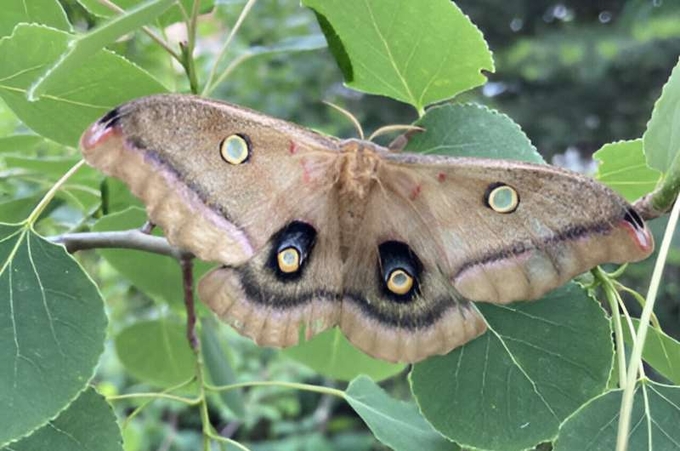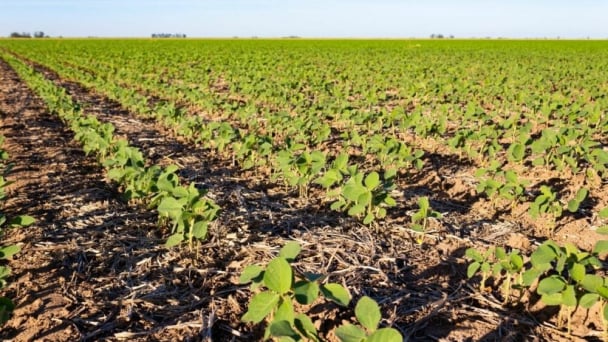May 16, 2025 | 12:06 GMT +7
May 16, 2025 | 12:06 GMT +7
Hotline: 0913.378.918
May 16, 2025 | 12:06 GMT +7
Hotline: 0913.378.918

Fully grown native polyphemus moths have wingspans of more than six inches, distinctive eye spots, and larvae with a taste for leaves of many of the same trees as spongy moth caterpillars. Credit: Rick Lindroth
An invasive insect with an insatiable appetite can cause serious problems for a favorite native moth that likes the same food source—even though the two are never in direct competition for a meal, according to new research, published in the journal Ecology and Evolution, from University of Wisconsin–Madison ecologists.
Since the early 2000s, spongy moth caterpillars, an import from Europe, have flexed their gustatory muscle in Wisconsin by stripping entire stands of trees of their leaves during late spring and early summer in remarkably destructive feeding binges. While spongy moth outbreaks wax and wane, the caterpillars can show up in significant numbers, seemingly out of the blue.
That was the case in 2021 when Rick Lindroth, entomology professor emeritus, and members of his lab trekked into a research forest of quaking aspen trees Lindroth had planted in 2010 just a few miles from UW–Madison at the university's Arlington Agricultural Research Station. The team was excited to begin planned research after losing much of the 2020 field work season to the COVID pandemic.
"There were spongy moth egg masses everywhere," Lindroth says. "We wanted to begin some experiments, but there were too many invasive insects to proceed. There was no way they could be removed. We thought we were sunk."
In a stroke of good fortune, Lindroth says, his lab had an extra pair of hands that summer: Patricia Fernandez, an ecologist and professor visiting on a Fulbright Fellowship from the University of Buenos Aires. Lindroth and Fernandez formulated a new research plan. They knew the spongy moth caterpillars were likely to chomp up every leaf on their trees, so why not study the aftermath?
One aspect of Lindroth's prior work had been exploring how different genetic and environmental factors shape the way plants defend themselves against attack. The researchers wondered whether an aspen tree's defenses—rallied against marauding, invasive spongy moth caterpillars—might do unusual harm to native species that have evolved to feed on trees with baseline levels of chemical protection.
"Any wild plant is defended against an array of herbivores via a number of mechanisms, and chemistry is one of the most important," Lindroth says. "Aspen trees—like their relatives, willow trees—produce a suite of salicylate-like compounds, close to aspirin, that act as toxins to protect the trees from many insects."
Because the spongy moth caterpillar ends its leaf-eating spree relatively early in the aspen tree's growing season, the defoliated trees produce a second flush of leaves to capture enough energy to survive (if not necessarily thrive) through the winter and into the next growth year.
As expected, that second green canopy of leaves appeared by early July in Lindroth's forest plot. But the backup crop of leaves was different in at least one important aspect.
"Those trees had cranked up their defenses," Lindroth says. "By mid-summer, they produced an entirely new set of leaves that had, on average, an eight-times higher concentration of defense chemicals."
By then, the spongy moth caterpillar culprits are pupating and changing into moths. But mid-summer is when caterpillars of the striking, native polyphemus moth—second largest moth in North America—are hatching and trying to fill their own rumbling stomachs.
In their lab, the researchers fed some polyphemus caterpillars leaves from the spongy-moth-infested plot and other polyphemus caterpillars leaves from a stand of aspen trees untouched by spongy moths (despite growing just 6 kilometers away).
Less than 18% of the native moth caterpillars fed on the high-toxin leaves left in the spongy moth's wake survived, while the polyphemus caterpillars fed from the undamaged trees were about four times as likely to survive to their next life stage.
"We're seeing an invasive species harm a native species—a cherished, charismatic, beautiful moth—by changing the quality of its food plant. Without the two ever meeting each other," Lindroth says.
(Phys.org)

(VAN) Fourth most important food crop in peril as Latin America and Caribbean suffer from slow-onset climate disaster.

(VAN) Shifting market dynamics and the noise around new legislation has propelled Trouw Nutrition’s research around early life nutrition in poultry. Today, it continues to be a key area of research.

(VAN) India is concerned about its food security and the livelihoods of its farmers if more US food imports are allowed.

(VAN) FAO's Director-General emphasises the need to work together to transform agrifood systems.

(VAN) Europe is facing its worst outbreak of foot-and-mouth since the start of the century.

(VAN) The central authorities, in early April, released a 10-year plan for rural vitalization.

(VAN) Viterra marked a significant milestone in its carbon measurement program in Argentina, called Ígaris, reaching 1 million soybean hectares measured.